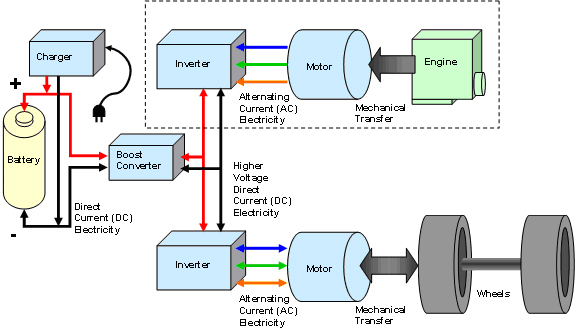- 积分
- 10123
- 回帖
- 0
- 西莫币
-
- 贡献
-
- 威望
-
- 存款
-
- 阅读权限
- 120
- 最后登录
- 1970-1-1
该用户从未签到
|
楼主 |
发表于 2010-3-11 10:19
|
显示全部楼层
来自: 中国辽宁大连
Power Electronics and Electrical Machines
Advanced electric drive vehicles such as hybrid-electric vehicles,plug-in hybrid electric vehicles, fuel cell electric vehicles, and pureelectric vehicles, require power electronics and electrical machines(PEEM) to function. These devices allow the vehicle to use energy fromthe battery to assist in the propulsion of the vehicle, either on theirown or in combination with an engine. Figure 1 is a simple diagram ofan electric system drive, where the inverter (power electronics) takesdirect current (DC) electricity from the battery and converts it toalternating current (AC) electricity and sends it to the motor. Theelectric motor (electric machine) uses the AC current to create torque(mechanical power) to power the wheels for propulsion. Note that thearrows point both ways; this is because the electric machine can alsoact as a generator and help the vehicle slow down when coming to astop. This sends energy back through the inverter and into the batteryto recharge it. | Figure 1. A simple diagram of a HEV traction drive system. |
Figure 2 is a diagram of a more complex PEEM system in a plug-inhybrid electric vehicle. This vehicle uses two electrical machines; oneas a generator connected to the engine and another as a motor to drivethe wheels. Each of these machines is connected to an inverter, and thetwo inverters run at a higher voltage than the battery. To achieve thishigh voltage, another power electronics device called a boost converterboosts the battery voltage before sending the DC electricity to theinverters. Notice that the battery charger is considered a powerelectronics device, as are all of the blue components, and that all ofthe components inside the dashed box in Figure 2 could be replaced by ahydrogen fuel cell to create a fuel cell powered PHEV. Key componentsfor hybrid and electric vehicles include motors, inverters/converters,sensors, control systems, and other interface electronics. | Figure 2. A more complex diagram of PEEM in a plug-in hybrid electric vehicle (PHEV). |
Advanced technology vehicles such as hybrid electric vehicles(HEVs), plug-in hybrid electric vehicles (PHEVs), fuel cell hybridelectric vehicles (FCHEVs), and electric vehicles (EVs) can help meetimportant DOE goals, such as petroleum reduction. However, modern dayPEEM technology is not sufficient to enable market-viable PHEVs,FCHEVs, and EVs. So, the Vehicle Technologies Program aims to developthese technologies by setting strategic goals for PEEM, and undertakingresearch projects that are carried out through collaboration amonggovernment, national laboratories, academia, and industry partners.
Achieving the PEEM goals will require the development of newtechnologies. These new technologies must be compatible withhigh-volume manufacturing and must ensure high reliability, efficiency,and ruggedness. These technologies must also reduce cost, weight, andvolume. Of all these challenges, cost is the greatest. PEEM projectpartners work together to ensure that technical attributes,vehicle-scale manufacturing, and cost sensitivities are addressed in atimely fashion and that the resulting technologies can be adopted bycompanies willing and able to supply products to automakers. |
|


 加群请注明论坛用户名及所从事专业,否则不予通过
加群请注明论坛用户名及所从事专业,否则不予通过
 加群请注明论坛用户名及所从事专业,否则不予通过
加群请注明论坛用户名及所从事专业,否则不予通过
 加群请注明论坛用户名及所从事专业,否则不予通过
加群请注明论坛用户名及所从事专业,否则不予通过
 加群请注明论坛用户名及所从事专业,否则不予通过
加群请注明论坛用户名及所从事专业,否则不予通过
 加群请注明论坛用户名及所从事专业,否则不予通过
加群请注明论坛用户名及所从事专业,否则不予通过
 加群请注明论坛用户名及所从事专业,否则不予通过
加群请注明论坛用户名及所从事专业,否则不予通过
 加群请注明论坛用户名及所从事专业,否则不予通过
加群请注明论坛用户名及所从事专业,否则不予通过
 加群请注明论坛用户名及所从事专业,否则不予通过
加群请注明论坛用户名及所从事专业,否则不予通过
 加群请注明论坛用户名及所从事专业,否则不予通过
加群请注明论坛用户名及所从事专业,否则不予通过
 加群请注明论坛用户名及所从事专业,否则不予通过
加群请注明论坛用户名及所从事专业,否则不予通过
 加群请注明论坛用户名及所从事专业,否则不予通过
加群请注明论坛用户名及所从事专业,否则不予通过
 加群请注明论坛用户名及所从事专业,否则不予通过
加群请注明论坛用户名及所从事专业,否则不予通过
 加群请注明论坛用户名及所从事专业,否则不予通过
加群请注明论坛用户名及所从事专业,否则不予通过
 加群请注明论坛用户名及所从事专业,否则不予通过
加群请注明论坛用户名及所从事专业,否则不予通过
 加群请注明论坛用户名及所从事专业,否则不予通过
加群请注明论坛用户名及所从事专业,否则不予通过
 加群请注明论坛用户名及所从事专业,否则不予通过
加群请注明论坛用户名及所从事专业,否则不予通过
 加群请注明论坛用户名及所从事专业,否则不予通过
加群请注明论坛用户名及所从事专业,否则不予通过
 加群请注明论坛用户名及所从事专业,否则不予通过
加群请注明论坛用户名及所从事专业,否则不予通过
 加群请注明论坛用户名及所从事专业,否则不予通过
加群请注明论坛用户名及所从事专业,否则不予通过
 加群请注明论坛用户名及所从事专业,否则不予通过
加群请注明论坛用户名及所从事专业,否则不予通过
 |Archiver|手机版|小黑屋|西莫电机圈
( 浙ICP备10025899号-3|
|Archiver|手机版|小黑屋|西莫电机圈
( 浙ICP备10025899号-3|![]() 浙公网安备33010502012192号 )
浙公网安备33010502012192号 )